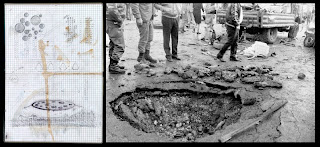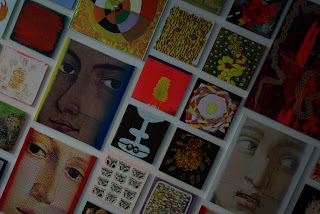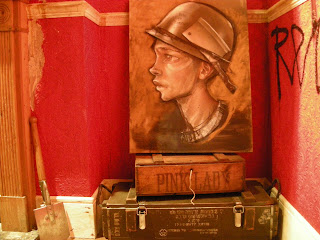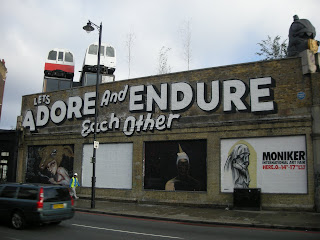Thursday, 9 December 2010
Tuesday, 30 November 2010
Byroglyphics 'Subsidiary' @ Signal Gallery
exhibition open until 11th Dec
Evocative is the word that comes to mind when admiring artist Byroglyphics’
piece 'Departure Lounge'. Yet, what is it that makes his work so magnetic? Is it
the subject matter, the colour palette, the brush strokes, or the concept of the
artwork as a whole?
Currently on show at the Signal Gallery in Hoxton, the collage-type painting is
part of Byroglyphics’ experimental collection, ‘Subsidiary’ an exhibition which
places work like ‘Departure Lounge’ alongside contrasting pieces of art to evoke
a unique kind of thought process.
Being Byroglyphics', aka Russ Mills’ second
solo exhibition, he is this time around using his background in illustration and
animated film making to push the boundaries even further, using the freedom of
the digital medium to its fullest.
‘Subsidiary’ establishes a good mix of drawing and collages, applied through
various technical forms to emphasize the depth and profound darkness suggestive
of Mills’ subject matter. Additionally, the extreme use of shaded dark acrylic
adds intensity and character to his already powerful and suggestive pieces, many
of which depict portraits of appealing female figures that seem to emit an
immensely challenging image.
Many of Byroglyphics pieces carry with them accompanying titles which are just
as thought provoking as the works themselves. For example, listed among
antidepressants, ‘Desipramine’ and ‘Sinequan’ perhaps omit the same sense of
euphoria as Mills is trying to capture in the images these titles represent. His
strong brush strokes fulfil the artwork’s multi-dimensional potential, while the
accompanying drawing-effect forms lingering subtle emotions within each image.
The confidence and sex appeal in the subjects’ appearance emphasises this
aforementioned magnetism, especially in the portraits illustrated on Chinese
comic pages.
‘Subsidiary’ proves why Byroglyphics is a remarkable talent in the urban art
scene, drawing in people’s attention with his personal fascination for one’s
‘inner demons’. Unusual are his artistic features which combine distinctive
looks from the animal kingdom with realistic human figures. Perhaps striking but
not surprising, the majority of his exhibited artwork this time was marked sold
by the second day of the exhibition.
Photographs provided by Signal Gallery

Departure lounge

Tuesday, 23 November 2010
Vibrant, lively, and even a little surreal are a few ways to describe the latest pieces by six worldwide artists at the Black Rat Projects' Gallery. Focusing upon the struggles within society, the exhibition's artists have 'urbanised' fine art, making each piece truly innovative. Through a diverse range of mediums, each artist encourages viewers to take a second look and uncover the varying portrayals of social resistance in each piece.
One artist, Matt Small, uses his art to reflect everyday native people in a vivid and powerful way. The size of his sculptures draws you in, but it is the way Small represents a nation in such a noble way which is most captivating. Featuring alongside Small is New York artist Swoon whose enormous installation of a disaster on mixed media adds a different dimension to the exhibition. The image of the small boy featured in Swoon's piece catches the observer's eye, and helps highlight the enormity of the disaster surrounding him.
Other artists involved in the 'Small Acts of Resistance' exhibition include Peter Kennard, whose love for photomontage speaks for a new era of social struggle. His collaborative project with Tarek Salhany focuses on an obscure layering composition based upon a newspaper surface, giving the black and white portraits a hidden emotion which as viewers we try to uncover.
Danish artist Armstock's simple yet profound drawings also depict this sense of hidden emotion and resistance. As if the artist is one step ahead of us as viewers, the rough charcoal conveys the medium while allowing an observer to try to uncover and envisage the scene more vividly. The central focus of Armstock's work is interaction; between the work and the viewer, and between tension and conflict, encapsulating the theme of social struggles.
Know Hope is an Israeli artist whose work pieces together a combination of white birds, white flags and raindrops. His focus is on producing a kind of non-linear narrative in his work to establish a connection between art and the social environment it is created within. This direct connection between art and social environment is also dealt with by DotMasters who in a sense expose humankind by using their work to confront the prominence of vandalism in society. A selection of scenes from CCTV frames illustrates the violence occurring in current society, something which shocks viewers but also acts to inspire resistance and encourage more creative talent on the street.
Saturday, 20 November 2010
Photographs provided by galleries

Friday, 29 October 2010








Friday, 15 October 2010






















































